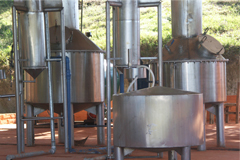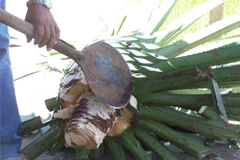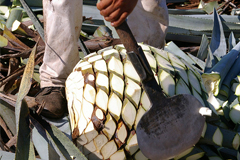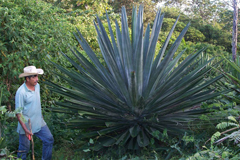Back to list news




|
RAICILLA Goes Mainstream
December 09, 2009
The same conditions that have made the state of Jalisco the perfect place for tequila production has made it likewise perfect for the production of Raicilla. The process of growing and distilling the Agave cactus are virtually the same for Raicilla. In both cases, the cacti are grown for eight to ten years, their leaves are cut off, and their roots (called pinas, for their resemblance to pineapples) are baked for twenty-four hours. After baking, the roots are pulverized with mallets, and the remaining chunks and juice are fermented for approximately a week. This liquid is then distilled over a fire (originally, it was distilled over burning palm leaves over a great earthen oven dug into the ground). What results is Raicilla.
The way to distinguish the good Raicilla from the bad is to examine its surface for the “ring of pearls,” a line of tiny bubbles marking the circumference of the surface. Most “legitimate” raicillas lack this. A good place to get good Raicilla is El Tuito, which is an hour north of Vallarta. When in El Tuito, ask around and someone will lead you to a vendor. When drinking it, you can do shots backed up with lime, or mix it with a grapefruit soda; be careful here, because to cover up the taste can mean you will deceive yourself about how much you’ve drunk, and you will then suffer the notorious consequences of raicilla: hallucinations and a crushing hang-over the next day.
|
|
Raicilla is a notorious liquor, home grown in Puerto Vallarta and surrounding areas, was, until recently, the equivalent of American moonshine. It is a kind of mescal or tequila, as it is made from Agave cactus, but specifically from leguchilla cactus, which is not fine enough to make standard tequila. Lately, Raicilla has become legitimised and accepted in most Vallarta restaurants and bars, thanks to branding and tax payment. Vallarta now hosts a Raicilla festival in its main square downtown every spring (dates for the 2010 festival have not yet been confirmed). Locals prefer the bootleg style of presentation, usually in a two-litre soda bottle, or in a large glass jar, even though there are more respectable, labelled presentations of it.
|
|
Getting to El Tuito is simple and easy from Puerto Vallarta. Go to Insurgentes Street, a block east of Highway 200, and get on a bus marked with the town’s name. Halfway along, you’ll come to the recently inaugurated Botanical Gardens (which is well worth a visit), next you’ll pass Las Juntos Los Veranos, home of the world famous Los Veranos Canopy Tour, Vallarta’s oldest and one of the biggest zip-line adventure companies. The bus will drop you off on the highway in front of El Tuito, the population of which is approximately four thousand. You will find the locals friendly and helpful. Many from Vallarta escape the brutality of summer in the mountain village of El Tuito.
|
|
|

